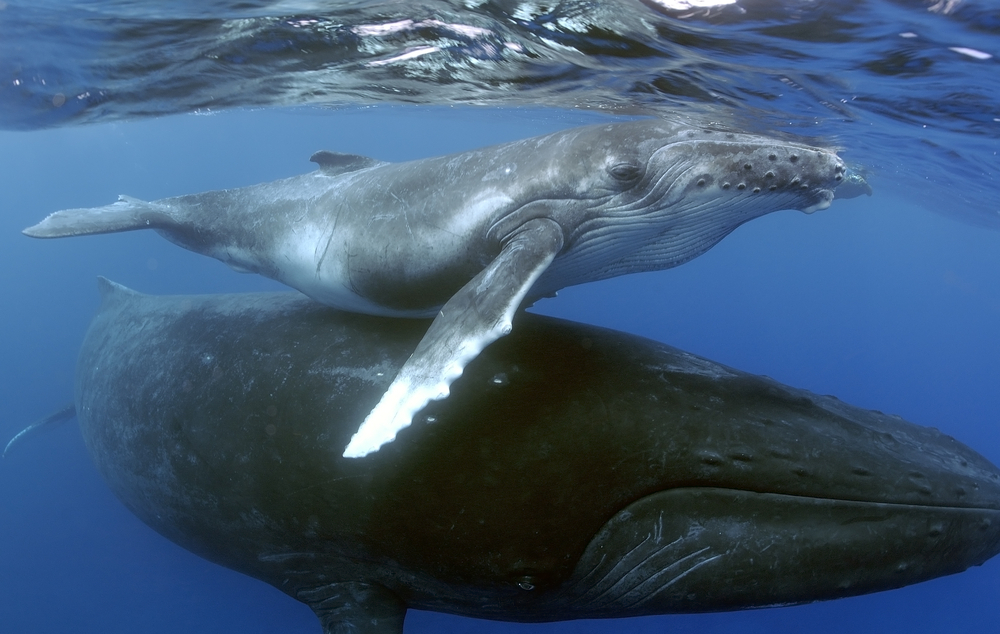
The sight of a humpback whale eating its dinner can be quite confronting teatime viewing. No one can accuse these animals of being fussy. With mighty mouths enormously agape, these leviathan marine mammals simply swim straight through great twisting spirals of small fish such as herring, gulping down their prey and squirting the brine out through their intricate baleen plates. It’s an astonishing sight, and a scene you wouldn’t want to accidentally swim into, as a few people almost have, Jonah style.
Of course, being species of baleen whale, they couldn’t possibly actually swallow a person whole—the threat has always been the other way around; humans hunted humpbacks to the brink of extinction before they received protection in the 1970s, and the species is still endangered. However an adult will smash its way through a ton of fish each day during the feeding season. But you’d be hungry too, if you’d just migrated 3000 miles from Maui in Hawaii to the Inside Passage off Alaska, without so much as a bite to eat en route, having already spent the winter fasting in the Caribbean.
As the extraordinary documentary entitled In the Feeding Ground of Humpback Whales explains, young mother humpbacks arrive at their summer haunts looking particularly gaunt, having used up nearly all of their body fat reserves feeding their calves. Crossing the immensity of the northern Pacific Ocean is an amazing journey to undertake at any time, let alone with a suckling youngster in tow, yet up to 800 young mum humpbacks make the trip each year, and this film follows their fortunes.
After a pregnancy that lasts a year, humpbacks are born at around 15-foot long and spend at least 12 months in very close contact with their mothers, literally sleeping on their backs and spending every moment with them. In the waters around Hawaii, where a large population resides each winter, the whales eat nothing. Dangers here include silky and tiger sharks, which harass the whales calves as the mother becomes increasing tired from a lack of food whilst nourishing a baby.
When the migration starts, the humpbacks face more threats, including from orcas, who will hunt down baby whales. The softer side of orcas is also shown, including some truly incredible footage of their clumsy mating techniques…
Fortunately, the whales observed in this film escape the predators that surround them, and instead the viewer is treated to an introduction to all the marine life that they share the ocean with as they move north, including turtles, pilot whales, Steller sea lions, long-beak dolphins and immense sperm whales with their gargantuan 54-foot-long heads. One of the most astonishing parts of the documentary is a section about a very special relationship that has evolved between a marine biologist called Anita and a white beluga whale named Wilma.

For the most part though, the focus is on the humpbacks, as they approach their feeding grounds in Alaska’s Inside Passage, where they will spend months gorging themselves on krill and herring, using sophisticated hunting techniques that the calf will learn from its mother. These include ‘bubble net’ fishing, where a group of whales will collaborate to surround a shoal of herring from below, sending up bubbles from their blowholes to confuse and contain the fish, before going in for the kill in dramatic filmmaker-pleasing fashion.
Humpbacks are known for their singing voice. The whales have a repertoire of over 600 sounds, and the males serenade the females with love songs that last up to 20 minutes and use a massive range of frequencies. They even compose complex tunes with other whales, creating melodies that evolve over time. NASA considered the song of the humpback such a moving acoustic experience that they sent a recording into space on board Voyager, which has recently become the first human made object to leave our solar system and travel into the outside universe.
It’s intriguing to consider that, if we do ever make contact with a civilisation beyond our own planet, one of the first sounds of Earth they will hear is the song of an amorous aquatic giant, from a species we almost obliterated. Thankfully, that disaster was averted, and we still share this third rock from the sun with these magnificent and sometime mystifying animal. For now, that is, because the whales face a more modern threat from the degradation of their feeding grounds due to climate change. Watch this video to appreciate why we must never risk losing these wonderful whales.
Watch In the Feeding Ground of Humpback Whales today and sign up for a 30-day free trial of Love Nature, the on-demand streaming service with the very best documentaries from right across our wild planet.
